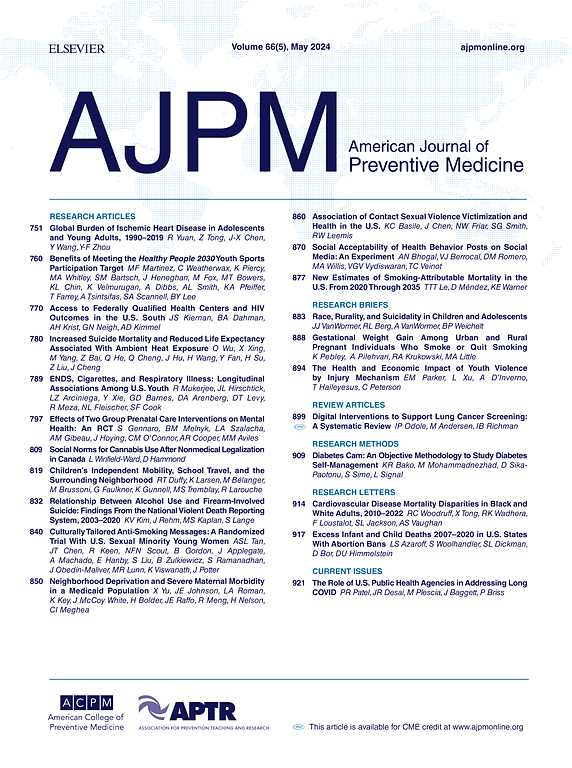Racial and Ethnic Disparities in Alcohol Consumption and Mortality in the U.S.
IF 4.5
2区 医学
Q1 MEDICINE, GENERAL & INTERNAL
引用次数: 0
Abstract
Introduction
Although there are racial/ethnic differences in alcohol use, there is little information about differences in mortality from all alcohol-related conditions or by cause of death. Furthermore, little is known about the degree to which racial/ethnic differences in mortality persist after adjusting for ethanol consumption. The purpose of this cross-sectional study was to comprehensively assess racial/ethnic differences in alcohol-attributable deaths and reduced life expectancy.
Methods
Alcohol prevalence data were from the Behavioral Risk Factor Surveillance System, and mortality data were from the National Vital Statistics System. Alcohol-attributable fractions and the Alcohol-Related Disease Impact application were used to assess alcohol-attributable deaths from 58 partially or wholly alcohol-attributable conditions in the U.S. during 2020–2021 (analyzed in 2024).
Results
White persons (60.9% of the population) accounted for 70.8% of all alcohol-attributable deaths and had the second-highest death rate (63.8 per 100,000) among racial/ethnic groups. American Indian/Alaska Native persons had the highest alcohol-attributable death rate (145.3) and the lowest average age of death (48.1 years). White and Asian, Native Hawaiian, or Pacific Islander persons tended to die of alcohol-attributable conditions from chronic diseases at relatively older ages, whereas people in other racial/ethnic groups tended to die at younger ages from alcohol-attributable acute causes of death. After adjusting for differences in per capita alcohol consumption, there remained fourfold differences in alcohol-attributable deaths by race/ethnicity.
Conclusions
Large differences in alcohol-attributable deaths across racial/ethnic groups were only partially explained by racial/ethnic differences in alcohol consumption. Implementing effective alcohol policies and addressing social determinants of health could reduce alcohol-related harms across race/ethnicities.
美国酒精消费和死亡率的种族差异
虽然在酒精使用方面存在种族/民族差异,但几乎没有关于所有酒精相关疾病或死因死亡率差异的信息。此外,在调整乙醇消耗量后,对种族/民族死亡率差异的持续程度知之甚少。本横断面研究的目的是全面评估酒精导致的死亡和预期寿命缩短的种族/民族差异。方法酒精患病率数据来源于行为危险因素监测系统,死亡率数据来源于国家生命统计系统。酒精归因分数和酒精相关疾病影响应用程序用于评估2020-2021年美国58种部分或完全酒精归因疾病的酒精归因死亡(分析于2024年)。结果白人(占人口的60.9%)占所有酒精导致死亡的70.8%,在种族/族裔群体中死亡率第二高(63.8 / 10万)。美洲印第安人/阿拉斯加土著人因酒精导致的死亡率最高(145.3),平均死亡年龄最低(48.1岁)。白人和亚洲人、夏威夷原住民或太平洋岛民往往在相对较老的年龄死于由酒精引起的慢性病,而其他种族/族裔群体往往在较年轻的年龄死于由酒精引起的急性死因。在调整了人均酒精消费量的差异后,不同种族/民族的酒精导致的死亡仍有四倍的差异。酒精导致的死亡在种族/民族群体中的巨大差异只能部分地用酒精消费的种族/民族差异来解释。实施有效的酒精政策和解决健康的社会决定因素可以减少跨种族/族裔的酒精相关危害。
本文章由计算机程序翻译,如有差异,请以英文原文为准。
求助全文
约1分钟内获得全文
求助全文
来源期刊

American Journal of Preventive Medicine
医学-公共卫生、环境卫生与职业卫生
CiteScore
8.60
自引率
1.80%
发文量
395
审稿时长
32 days
期刊介绍:
The American Journal of Preventive Medicine is the official journal of the American College of Preventive Medicine and the Association for Prevention Teaching and Research. It publishes articles in the areas of prevention research, teaching, practice and policy. Original research is published on interventions aimed at the prevention of chronic and acute disease and the promotion of individual and community health.
Of particular emphasis are papers that address the primary and secondary prevention of important clinical, behavioral and public health issues such as injury and violence, infectious disease, women''s health, smoking, sedentary behaviors and physical activity, nutrition, diabetes, obesity, and substance use disorders. Papers also address educational initiatives aimed at improving the ability of health professionals to provide effective clinical prevention and public health services. Papers on health services research pertinent to prevention and public health are also published. The journal also publishes official policy statements from the two co-sponsoring organizations, review articles, media reviews, and editorials. Finally, the journal periodically publishes supplements and special theme issues devoted to areas of current interest to the prevention community.
 求助内容:
求助内容: 应助结果提醒方式:
应助结果提醒方式:


